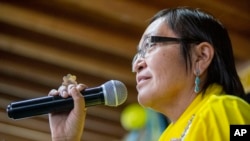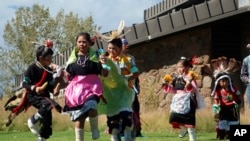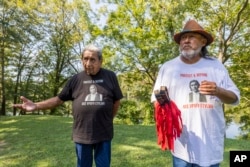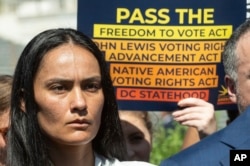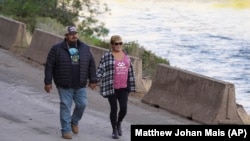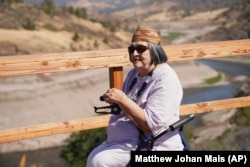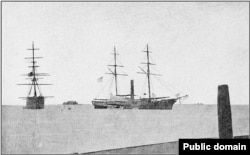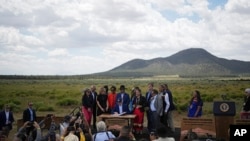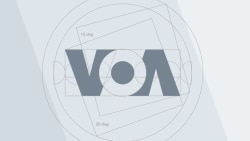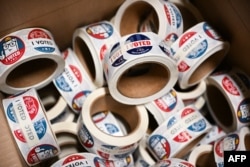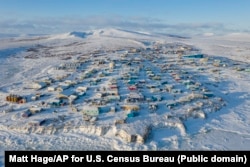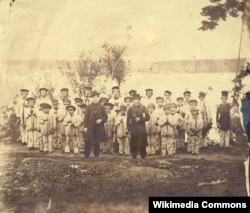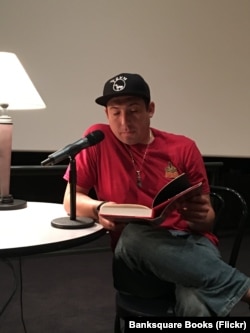Native Americans
One of the last Navajo Code Talkers from World War II dies at 107

John Kinsel Sr., one of the last remaining Navajo Code Talkers who transmitted messages during World War II based on the tribe's native language, has died. He was 107.
Navajo Nation officials in Window Rock announced Kinsel's death on Saturday.
Tribal President Buu Nygren has ordered all flags on the reservation to be flown at half-staff until Oct. 27 at sunset to honor Kinsel.
"Mr. Kinsel was a Marine who bravely and selflessly fought for all of us in the most terrifying circumstances with the greatest responsibility as a Navajo Code Talker," Nygren said in a statement Sunday.
With Kinsel's death, only two original Navajo Code Talkers are still alive: Former Navajo Chairman Peter MacDonald and Thomas H. Begay.
Hundreds of Navajos were recruited by the Marines to serve as Code Talkers during the war, transmitting messages based on their then-unwritten native language.
They confounded Japanese military cryptologists during World War II and participated in all assaults the Marines led in the Pacific from 1942 to 1945, including at Guadalcanal, Tarawa, Peleliu and Iwo Jima.
The Code Talkers sent thousands of messages without error on Japanese troop movements, battlefield tactics and other communications crucial to the war's ultimate outcome.
Kinsel was born in Cove, Arizona, and lived in the Navajo community of Lukachukai.
He enlisted in the Marines in 1942 and became an elite Code Talker, serving with the 9th Marine Regiment and the 3rd Marine Division during the Battle of Iwo Jima.
President Ronald Reagan established Navajo Code Talkers Day in 1982 and the Aug. 14 holiday honors all the tribes associated with the war effort.
The day is an Arizona state holiday and Navajo Nation holiday on the vast reservation that occupies portions of northeastern Arizona, northwestern New Mexico and southeastern Utah.
Native American news roundup Oct. 13 – 19, 2024

Indigenous Peoples Day and Columbus Day observed Monday
Some Americans this week celebrated Christopher Columbus’ October 1492 landing in the Western Hemisphere while others marked the alternative Indigenous Peoples’ Day commemorating the exploitation that began with Columbus’ arrival, which ultimately led to widespread displacement, violence, disease and enslavement.
The U.N. Committee on Non-Governmental Organizations in 1977 held the first International NGO Conference on Discrimination against Indigenous Populations in the Americas in Geneva. Attending delegates from Indigenous nations passed a resolution to recognize an “International Day of Solidarity with the Indigenous Peoples of the Americas.”
President Joe Biden in 2021 recognized Indigenous Peoples Day as a national — but not a federal — holiday. Today, more than two dozen states and many cities across the U.S. observe the day with powwows and other cultural events.
About 2,000 people gathered at the Getty Museum in Los Angeles to celebrate. VOA reporter Genia Dulot was there and filed this report:
Tribal protesters clash with police in nation’s capital
In Washington, D.C., the Indigenous People’s Day holiday brought confrontation between U.S. Park Police and protesters from the Muwekma Ohlone Tribe of California, who rode across the country on horseback along a "Trail of Truth" to lobby for federal recognition that the Interior Department's Bureau of Indian Affairs (BIA) denied decades ago.
The tribe claims descent from the Verona Band of Alameda County, which inhabited the San Francisco Bay Area for over 10,000 years.
In 1989 they petitioned the BIA for federal acknowledgment as the “Ohlone/Costanoan Muwekma Tribe.” The BIA rejected their application, citing a lack of evidence showing the tribe had continuously operated since 1927 as the same or an evolved tribal entity previously acknowledged.
Protests involving 25 or more people on the National Mall or other National Park Service (NPS)-controlled areas require a permit, which the group had not obtained. Tensions escalated when police attempted to remove the group and their horses.
"The Department of the Interior's posture with Native peoples is on full display," the group posted onFacebook. "Was Indian Country naive to think that Indigenous leadership at the top was going to change the institutional culture, colonial legal architecture, and systems of oppression that have always been the core function of the Department?"
In a statement to VOA, the NPS said the group has since dismantled their camp and submitted a permit application, which is under review.
"However, enforcement actions were taken, including the arrest of one person on October 16 for assaulting a police officer and other violations. On October 15, USPP officers arrested nine others for similar offenses," the statement said.
Minnesota tribe is latest to sue social media companies
CBS News reports this week that the Fond du Lac Band of Lake Superior Chippewa in Minnesota has joined four other tribes in a lawsuit against social media giants including Instagram, Snapchat, TikTok and YouTube for allegedly harming a Native American youth's mental health.
The 164-page complaint alleges that parent companies including Alphabet, ByteDance, Meta and Snap violated Minnesota laws by failing to warn users about the negative mental health effects of social media, particularly for children.
“They [Native teenagers] are more vulnerable because they've struggled with mental health because of isolation and poverty on some of the reservations,” attorney Tim Purdon, a partner in the law firm that filed the complaint, said during an interview in late July. “We seek dollars from them to be paid in our case directly to tribes to help abate or blunt or help fix the public mental health crisis that has resulted.”
Read more:
Navajo president calls for VP to resign
Navajo Nation president Buu Nygren has stripped Navajo vice president Richelle Montoya of her responsibilities and is calling for her resignation.
The announcement follows months of political tension within the tribe. In April, Montoya publicly accused the administration of intimidation and sexual harassment that she alleges took place during an August 2023 meeting in the president's office.
This prompted the tribal attorney to call for an independent investigation, which is still under way.
Nygren defended his actions in a news conference Tuesday, accusing the vice president of neglecting her official duties. He also cited Montoya’s decision to support a campaign to recall him as tribal leader.
“I welcome her resignation to make room for someone who wants to be a part of this administration,” Nygren said.
The rift between Nygren and Montoya has caused significant political upheaval, with tribal leaders and community members divided over the issues, further complicating governance and stability within the Navajo Nation.
Read more:
Lakota artist cites free speech rights, sues Colorado town
Danielle SeeWalker, a Hunkpapa Lakota artist from the Standing Rock Sioux Tribe, is suing the town of Vail, Colorado, after her artist residency was canceled.
As VOA reported in May, SeeWalker posted a painting titled “G is for Genocide” on Instagram. It showed a near-faceless woman wearing a feather and a keffiyeh, the traditional Bedouin headscarf that has become the symbol for solidarity with Palestinians.
“It is about me expressing the parallels between what is happening to the innocent people in Gaza ... to that of the genocide of Native American populations here in our lands,” SeeWalker wrote in her post.
The town of Vail said in a May Facebook post that its decision to cancel her residency “was not made in a vacuum; after releasing her name in an announcement, community members, including representatives from our local faith-based communities, raised concerns to town staff around SeeWalker's recent rhetoric on her social media platform about the Hamas-Israel war.”
Backed by the American Civil Liberties Union, SeeWalker claims her First Amendment rights were violated and is seeking damages.
Read more:
Indigenous Peoples Day celebrated with an eye on election
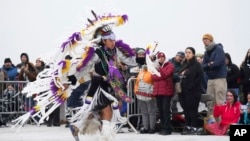
As Native Americans across the U.S. come together on Monday for Indigenous Peoples Day to celebrate their history and culture and acknowledge the ongoing challenges they face, many will do so with a focus on the election.
From a voting rally in Minneapolis featuring food, games and raffles to a public talk about the Native vote at Virginia Tech, the holiday, which comes about three weeks before Election Day, will feature a wide array of events geared toward Native voter mobilization and outreach amid a strong recognition of the power of their votes.
In 2020, Native voters proved decisive in the presidential election. Voter turnout on tribal land in Arizona increased dramatically compared with the previous presidential election, helping Joe Biden win a state that hadn’t supported a Democratic candidate in a White House contest since 1996.
Janeen Comenote, executive director of the National Urban Indian Family Coalition, which is involved with at least a dozen of these types of voting events across the country, said this year it’s especially important to mobilize Native voters because the country is selecting the president. But she cautioned that Native people are in no way a monolith in terms of how they vote.
“We’re really all about just getting Native voters out to vote, not telling them how to vote. But sort of understanding that you have a voice and you’re a democracy, a democracy that we helped create,” said Comenote, a citizen of the Quinault Indian Nation.
In Arizona, her coalition is partnering with the Phoenix Indian Center to hold a town hall Monday called “Democracy Is Indigenous: Power Of The Native Vote,” which will feature speakers and performances, along with Indigenous artwork centered on democracy.
In Apex, North Carolina, about 14 miles (23 kilometers) southwest of Raleigh, the coalition is working with the Triangle Native American Society for an event expected to include a celebration of the 100th anniversary of the Indian Citizenship Act of 1924 and a booth with nonpartisan voter information and giveaways.
While not a federal holiday, Indigenous Peoples Day is observed by 17 states, including Washington, South Dakota and Maine, as well as Washington, D.C., according to the Pew Research Center. It typically takes place on the second Monday in October, which is the same day as the Columbus Day federal holiday.
- By Genia Dulot
Los Angeles celebrates Indigenous’ Peoples Day before Columbus Day
Since 2019 the state of California officially celebrates Indigenous Peoples’ Day instead of the federally recognized Columbus Day, which falls on every second Monday in October. VOA’s Genia Dulot visited the celebration at the Getty Museum in Los Angeles, that drew around 2,000 people.
Native American news roundup October 6-12, 2024

VP candidates court minorities in battleground state of Arizona
As early voting launched Wednesday in the swing state of Arizona, both vice presidential candidates – Democratic Minnesota Gov. Tim Walz and Republican U.S. Senator JD Vance -- were in the state to rally Latina and Native voters ahead of the November election.
Walz met with tribal leaders of the Gila River Indian Community in the Phoenix area as part of a newly announced initiative to better engage Native American voters. He talked about Democratic presidential candidate and Vice President Kamala Harris' and his own commitment to tribal sovereignty and working "hand-in-hand" with tribes on issues of importance.
"What we've always said is if the children of our tribal nations are doing well, everyone's doing well," he said. "And we need to make sure that we're not the gatekeepers, that we're there as partners to make sure things work."
Following a rally in Tucson, Vance attended a town hall event hosted by the Conservative Political Action Conference in the city of Mesa, speaking directly to women and Latinos, who have traditionally favored Democrats.
Vance cited soaring grocery prices and border-related issues such as drug smuggling, which have hit women "especially hard."
"A lot of moms out there, especially Latino women in places like Arizona … are saying we don't want our kids playing on playgrounds where a bag of candy is actually disguised fentanyl or THC."
At the time of this writing, Harris was scheduled to visit Phoenix on Friday, and Trump was slated to hold a rally in Prescott Valley on Sunday.
California schools to teach Native American history, including genocide and resilience
A new California law, signed by Governor Gavin Newsom and authored by Assemblymember James Ramos, will require students to learn Native American history, including the atrocities committed against Indigenous tribes during Spanish colonization and the Gold Rush.
Ramos, the first Native Californian in the state legislature, introduced the bill to address gaps in education and ensure students learn both the tragedies and resilience of Native communities.
The law, effective January 1, 2025, mandates lessons on Native mistreatment in the fourth-grade curriculum, replacing the current optional content.
Tribal leaders support the law but advocate a more comprehensive approach, integrating not just tragedies but Native culture, language and contributions across subjects.
Ramos, a descendant of the Serrano tribe, emphasized the personal significance of the law, which aims to share the true history of California's Native peoples. Experts warn that successful implementation will require teacher training and significant funding to ensure the material is taught effectively and compassionately.
Read more:
Tribes at odds over historic site in Alabama
A legal conflict between the Muscogee (Creek) Nation and the Poarch Creek Indians over Hickory Ground, a sacred site in Alabama, has reignited tensions stemming from colonialism.
The dispute centers on the Poarch's construction of the Wind Creek Casino atop the site, which involved the removal of Muscogee human remains and artifacts. The Muscogee argue this violated the Native American Graves Protection and Repatriation Act (NAGPRA) and are appealing a 2021 ruling granting the Poarch sovereign immunity.
The Muscogee want the site to be restored and the remains returned, viewing the case as a defense of sacred sites and tribal sovereignty. The Poarch, meanwhile, claim they followed legal guidelines and reburied the remains, highlighting the economic importance of the casino to the region.
Both tribes have expressed interest in strengthening federal protections for sacred sites and potentially collaborating on a museum to highlight their shared Creek history.
Hickory Ground was the last capital of the Muscogee people before their forced removal in 1832 during the Trail of Tears. The Poarch Band of Creek Indians, a federally recognized tribe in Alabama since 1984, purchased the original Hickory Ground in 1980 under an agreement to preserve the site for 20 years. However, the Muscogee Nation claims that after this period, the Poarch excavated 57 Muscogee remains and thousands of artifacts to build a casino, sparking controversy over cultural preservation and respect for ancestral remains.
Read more:
Idaho state senator accused of racial slur of Native American candidate
The Idaho Republican Party has defended state Sen. Dan Foreman against allegations he told a Native American candidate to "go back where you came from" during a campaign event September 30.
Trish Carter-Goodheart, a member of the Nez Perce Tribe and a candidate for the Idaho House of Representatives, told Idaho's KTVB News that the comment came during a debate on discrimination in Idaho, which another candidate declared nonexistent.
"I basically just sat up and I said … 'Just because this isn't your lived experience does not mean that discrimination and racism don't exist today, and these are … very real experiences of so many Idahoans.'"
No recording of the event has surfaced. Foreman has denied the allegation as "patently false" and criticized media coverage of the event.
"In the final analysis, I suppose we must expect this type of behavior … It seems the more effective a conservative elected official is, the more that person is attacked by the left and most, not all, of the media," he posted on his Facebook page.
Carter-Goodheart included the quote in a news release last week, and her election opponent, Republican Rep. Lori McCann, told the Lewiston Tribune that "her statement is accurate."
"The Nez Perce Tribe refuses to tolerate this kind of hateful and divisive politics, and we ask other elected leaders in this region to stand with us in pushing back against such offensive behavior," the tribe said in an official statement.
Native American vote could swing the election — but in which direction?

In the final weeks of the 2024 election, Native American organizers are intensifying efforts to increase voter turnout, recognizing the impact of the Native vote, especially in swing states like Arizona and Wisconsin.
Advocacy groups like the Native American Rights Fund continue to address barriers to the ballot box, such as isolation, poor infrastructure and limited internet access, along with restrictions on in-person voter registration and early voting.
New challenges in Arizona
Arizona, home to 22 Native tribes, played a key role in the 2020 Democratic victory.
However, a recent voter registration glitch in the state may affect up to 218,000 voters, more than double previous estimates. The issue stems from an error in the driver's license database that flagged some individuals as having proved citizenship when they had not.
A recording obtained by The Washington Post revealed concerns among Arizona Democratic leaders about how resolving the error could either disenfranchise voters or spark conspiracy theories. Despite the glitch, the Arizona Supreme Court ruled that those affected can still vote in federal and state elections.
Jaynie Parrish, executive director of Arizona Native Vote, said the impact on Native voters remains unclear. She stressed that Native Americans face ongoing challenges when voting, including Arizona's requirement to show proof of a physical address at the polls.
“We rely on post office boxes,” Parrish said, explaining that early voters can use a driver's license or tribal I.D. “We just have to keep reminding our community what identification they need for Election Day. Our best defense is offense.”
Voting based on issues, not party
University of New Mexico Professor Gabriel R. Sanchez said Native American voting preferences haven’t been well-studied.
“The assumption that they are overwhelmingly Democrat isn’t backed by data,” Sanchez told VOA.
His polling shows the majority of Native voters lean Democratic but not as strongly as other minority groups like Black and Latino voters. In the 2020 election, 60% of Native Americans supported Joe Biden, but this dropped slightly by 2022.
“Native voters tell us they aren’t really partisan,” Sanchez said. “They evaluate which party better addresses tribal issues each election cycle.”
As an example, in an editorial Monday in the Navajo Times, Francine Bradley-Arthur, a Navajo organizer and co-founder of Freedom House in St. Michaels, Arizona, explains why many Navajos support Donald Trump.
“In Navajo culture, life is sacred, including life in the womb,” she writes. “Trump’s administration upheld pro-life values that resonate deeply with our traditions.”
She recalls that as attorney general of California, Kamala Harris opposed “at least 15 tribal land-into-trust applications,” undermining the tribes’ ability to reclaim lost land.
The Kamala Harris-Tim Walz campaign this week launched an initiative to better engage Native communities through culturally appropriate outreach. Minnesota Lieutenant Governor Peggy Flanagan announced the program Wednesday during an October 2 event hosted by the Shakopee Mdewakanton Sioux Community.
"Vice President Harris has been a fierce advocate for tribal sovereignty, working to secure funding for health care, education and economic development that truly empowers our communities. … And let's not forget her running mate, who I have the privilege of knowing a thing or two about," Flanagan told reporters during a press call later in the day.
Flanagan, a member of the White Earth Band of Ojibwe, was elected alongside Governor Tim Walz in 2018 and reelected in 2022. Native American voters are mindful that if the Harris-Walz ticket succeeds, she would become the first Native American woman to serve as a state governor.
VP candidates’ debate
On October 1, vice presidential candidates Walz and JD Vance debated key topics like immigration and abortion. Native commentators expressed disappointment on a Facebook discussion hosted by Native News Online, noting the debate overlooked issues crucial to Native voters, such as tribal sovereignty and climate change.
Judith LeBlanc, Caddo Tribe member and director of the Native Organizers Alliance, said she was disappointed Walz didn’t highlight his work with Flanagan.
Aaron Payment, former chair of the Sault Ste. Marie Tribe of Chippewa Indians, pointed out that Native voters in swing states can help Democrats win.
"Are candidates concerned that if they start talking pro-Indian, then all of a sudden they're going to be considered radical or … in the back pocket of American Indians?" Payment asked.
Trump's proposal
The candidates did discuss Trump’s plan to open federal land for housing construction. LeBlanc criticized this proposal in a Native News Online editorial, calling it an overreach and warning that it could lead to seizing tribal lands for development.
During the Facebook discussion, Levi Rickert, editor of Native News Online, shifted focus to the Montana Senate debate between Jon Tester and Republican Tim Sheehy.
Sheehy has faced criticism for past racially charged remarks about the Crow Tribe.Tester confronted Sheehy, telling him to apologize for his comments. Sheehy admitted his remarks were insensitive, blaming them on military culture.
Payment noted that Sheehy's support has increased in Montana, but with Native Americans making up 6.4% of the vote, it could still swing.
Tribes celebrate end of largest dam removal project in US history
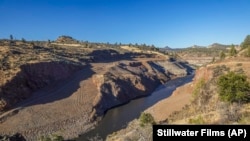
The largest dam removal project in U.S. history was completed Wednesday, marking a major victory for tribes in the region who fought for decades to free hundreds of miles of the Klamath River near the California-Oregon border.
Through protests, testimony and lawsuits, local tribes showcased the environmental devastation due to the four towering hydroelectric dams, especially to salmon, which are culturally and spiritually significant to tribes in the region. The dams cut salmon off from their historic habitat and caused them to die in alarming numbers because of bad water-quality conditions.
Without the tribes' work "to point out the damage that these dams were doing, not only to the environment, but to the social and cultural fabric of these tribal nations, there would be no dam removal," said Mark Bransom, chief executive of the Klamath River Renewal Corporation, the nonprofit entity created to oversee the project.
Power company PacifiCorp built the dams to generate electricity between 1918 and 1962. But the structures halted the natural flow of the waterway that was once known as the third-largest salmon-producing river on the West Coast. They disrupted the life cycle of the region's salmon, which spend most of their life in the Pacific Ocean but return to the chilly mountain streams to lay eggs.
At the same time, the dams produced only a small fraction of PacifiCorp's energy at full capacity — enough to power about 70,000 homes. They also didn't provide irrigation, drinking water or flood control, according to Klamath River Renewal Corporation.
Since breaching the dams, salmon regained access to their habitat, water temperature decreased and its quality improved, said Michael Belchik, senior water policy analyst for the Yurok Tribe.
But tribal advocates and activists see their work as far from finished, with some already refocusing their efforts on revegetation and other restoration work on the Klamath River and the surrounding land.
Here's a look at just a few of the many tribal members at the center of this struggle for dam removal:
'I really felt an urgency'
When Karuk tribal member Molli Myers took her first major step into the fight for Klamath dam removal, she was six months pregnant, had a toddler in tow and was in a foreign country for the first time. It was 2004 and she had organized a group of about 25 tribal members to fly to Scotland for the annual general stockholders meeting for Scottish Power, PacifiCorp's parent company at the time.
For hours, they protested outside with signs, sang and played drums. They cooked fish on Calton Hill over a fire of scotch barrels and gave it out to locals as they explained why they were there.
"I really felt an urgency because I was having babies," said Myers, who was born and raised in the middle Klamath in a traditional fishing family. "And so for me I was internalizing the responsibility to take care of their future."
The initial trigger for her to act came two years before that when she saw some of the tens of thousands of salmon die in the river from a bacterial outbreak caused by low water and warm temperatures.
"Looking back on it now I wonder where would we be if that hadn't happened," said Myers, 41. "Looking back on it now I can say, 'Was this our creator's call to action?' "
She spent the next two decades protesting and flooding state and federal meetings with tribal testimony, including waiting with other tribal members at the doors of a Berkshire Hathaway shareholder meeting at 4 a.m. in 2007 to ask Warren Buffett what he was going to do about the dams. PacifiCorp was at that point part of Buffett's Berkshire Hathaway Inc. conglomerate.
Today, those same children with her in Scotland are 21 and 19, and with the dams gone Myers said she sees the hope they and her other three children have about the future.
"They can do whatever needs to get done because they saw it happen, they lived it, so now there's no impossible for them," she said.
'His vision became reality'
For Yurok elder Jacqueline Winter, her feelings on the newly free-flowing river are more complicated. The 89-year-old's son, Troy Fletcher, was the tribe's point person for dam removal for two decades, testifying in front of the U.S. Congress and presenting to state and federal regulatory committees.
But his true power came through his ability to bring people with radically conflicting viewpoints — from farmers to commercial fishers to tribal members — together. Winter said that came from his belief that everyone living along the river are relatives and deserve to be heard.
"We're all family. None of us can be left hurting and all of us have to give a little," she said was his message.
But at 53, the former executive director for the Yurok Tribe died unexpectedly from a heart attack, nearly a decade before that vision of a free-flowing river would finally be realized. Winter said when she saw the dams breached last month, it felt like his spirit was there through those he touched and she could finally let him go.
"His vision became reality and I think he never doubted it," she said. "He never doubted it. And those who worked closely with him never doubted it."
'Protect those fish'
Former Klamath Tribes Chairman Jeff Mitchell's work since the 1970s for dam removal came out of the belief that the salmon are their relatives.
"They were gifted to us by our creator and given to us to preserve and to protect and also to help give us life," said Mitchell, chair of the tribe's Culture and Heritage Committee. "As such, the creator also instructed us to make sure that we do everything in our power to protect those fish."
The Klamath River's headwaters lie on the tribe's homelands in Oregon, and members once depended on salmon for 25% of their food. But for more than a century their waters have not held any salmon, he said.
Mitchell and other tribal members' fight to bring them back has cycled through several forms. There were the years of protesting, even gathering carcasses of fish after the 2002 fish kill and leaving them on the doorsteps of federal office buildings. There were his days of walking the halls of the state Legislature in Salem, Oregon, meeting with lawmakers about the millions in funding needed to make dam removal happen.
Today, he said he feels like they achieved the impossible, but there's still more work to do.
"I'm happy that the dams are gone and we have passage," he said. "But now I'm thinking about what are those fish coming home to. And that's really the focus now, is how do we get the parties to start taking restoration actions and making that the top priority in all of this?"
Army returns remains of 9 Indigenous children who died at boarding school over a century ago

The remains of nine more Native American children who died at a notorious government-run boarding school in Pennsylvania over a century ago were disinterred from a small Army cemetery and returned to families, authorities said Wednesday.
The remains were buried on the grounds of the Carlisle Barracks, home of the U.S. Army War College. The children attended the former Carlisle Indian Industrial School, where thousands of Indigenous children were taken from their families and forced to assimilate to white society as a matter of U.S. policy.
The Office of Army Cemeteries said it concluded the remains of nine children found in the graves were "biologically consistent" with information contained in their student and burial records. The remains were transferred to the children's families. Most have already been reburied on Native lands, Army officials said Wednesday.
Workers also disinterred a grave thought to have belonged to a Wichita tribe child named Alfred Charko, but the remains weren't consistent with those of a 15-year-old boy, the Army said. The remains were reburied in the same grave, and the grave was marked unknown. Army officials said they would try to locate Alfred's gravesite.
"The Army team extends our deepest condolences to the Wichita and Affiliated Tribe," Karen Durham-Aguilera, executive director of the Office of Army Cemeteries, said in a statement. "The Army is committed to seeking all resources that could lead us to more information on where Alfred may be located and to help us identify and return the unknown children in the Carlisle Barracks Post Cemetery."
The nine children whose remains were returned were identified Wednesday as Fanny Chargingshield, James Cornman and Samuel Flying Horse, from the Oglala Sioux Tribe; Almeda Heavy Hair, Bishop L. Shield and John Bull, from the Gros Ventre Tribe of the Fort Belknap Indian Community; Kati Rosskidwits, from the Wichita and Affiliated Tribes; Albert Mekko, from the Seminole Nation of Oklahoma; and William Norkok, from the Eastern Shoshone Tribe.
The Army declined to release details on one grave disinterment, saying the tribe asked for privacy.
More than 10,000 children from more than 140 tribes passed through the school between 1879 and 1918, including Olympian Jim Thorpe. Founded by an Army officer, the school cut their braids, dressed them in military-style uniforms, punished them for speaking their native languages and gave them European names.
The children — often taken against the will of their parents — endured harsh conditions that sometimes led to death from tuberculosis and other diseases. The remains of some of those who died were returned to their tribes. The rest are buried in Carlisle.
Native American news roundup September 22-28, 2024

Candidate Trump makes big promise to unrecognized NC tribe
Former President Donald Trump, speaking at a campaign rally in Wilmington, N.C., on Saturday, promised that if elected again, he would grant the Lumbee tribe federal recognition, along with access to federal benefits, services and protections.
"The Lumbee Tribe has been wrongfully denied federal recognition for more than a century," Trump said. "We're going to fix it. We'll fix it right at the beginning."
Historically, the tribe has been known by several names, including Tuscarora, Croatan, Cheraw and Cherokee. In 1953, they changed their name from "Cherokee Indians of Robeson County" to the "Lumbee Indians of North Carolina."
In her book "The Lumbee Indians: An American Struggle", University of North Carolina history professor Malinda Maynor Lowery, a member of the Lumbee community, describes the tribe as descendants of several tribes in eastern North Carolina, as well as free European and enslaved African settlers who lived in the tribe's homeland.
In 1956, Public Law 570, also known as the "Lumbee Act," acknowledged the tribe as an "admixture of colonial blood with certain coastal tribes of Indians" but denied them federal services. In the 1990s, the Department of the Interior rejected their petition for federal recognition because they could not prove cultural, political or genealogical ties to any historic tribe.
The Lumbee tribe has repeatedly sought federal recognition through Congress but has never succeeded in getting Senate approval. The Eastern Band of Cherokee Indians (EBCI), the only federally recognized tribe in North Carolina, opposes Lumbee recognition.
"It's not just the Lumbee," former ECBI Chief Richard Sneed told VOA in 2022. "It's any group trying to bypass the Office of Federal Acknowledgment. Congress isn't equipped to do the necessary research to determine whether a group is an authentic historic tribe."
The Lumbee tribe did not respond to VOA's request for comment.
Navy apologizes to Tlingit for historic attacks
The U.S. Navy has formally apologized for its 1869 bombardment of the Alaska Native village of Kake, more than 140 years after the attack. During a ceremony held in Kake on Sunday, Rear Admiral Mark B. Sucato expressed the Navy's regret, marking the first of two planned apologies for military actions against Alaska Native communities in the late 1800s.
The attacks on Kake and Angoon occurred shortly after the U.S. acquired Alaska from Russia in 1867, when the U.S. Army and Navy were patrolling the region. Sailors aboard the USS Saginaw fired on Kake's three villages and two forts, completely destroying the community. The Navy acknowledged that, following the bombardment, landing parties set the village ablaze, causing the death of "possibly one elderly Kake woman" and leaving many villagers to die of exposure during the harsh winter.
The attack on Kake was triggered by the killing of two Tlingit men by a sentry, which may have led to the killing of two settlers, prompting the USS Saginaw to be dispatched to "seize a few of their chiefs as hostages" and "burn their villages." While no one died during the bombardment itself, the destruction of food supplies and shelters led to many deaths from starvation.
Thirteen years later, the Navy bombarded the village of Angoon following a dispute over the death of a Tlingit traditional healer. When the tribe's request for compensation was denied, Commander Edgar Merriman ordered the bombing.
A second ceremony is scheduled for October 26 to commemorate the anniversary of the Angoon bombardment.
Read more:
Judge rules tribes, conservation groups cannot join national monument lawsuit
A legal battle has erupted between Arizona Governor Katie Hobbs and the Republican-controlled state legislature over President Joe Biden's 2023 designation of the Baaj Nwaavjo I'tah Kukveni Ancestral Footprints of the Grand Canyon National Monument.
The land, considered sacred by several Northern Arizona tribes, was protected from future mining under the monument's designation. All 22 of Arizona's federally recognized tribes contributed to the drafting of the monument designation, but Republicans argue that the designation exceeds presidential authority and violates the Arizona Wilderness Act of 1984, as some wilderness-designated lands fall within the national monument's boundaries.
U.S. District Court Judge Stephen McNamee allowed Hobbs and Attorney General Kris Mayes to intervene in the case, as they argue that only the state's executive branch, led by Hobbs, has the authority to sue on behalf of the state's interests. The Biden administration contends that only Congress can reverse a national monument designation, and that state lawmakers lack the legal standing to sue.
While Hobbs and Mayes were granted participation, the judge denied requests from Native American tribes and environmental groups to join the defense. A trial date has yet to be set.
"Baaj Nwaavjo" means "where tribes roam" in the Havasupai language, while "I'tah Kukveni" translates to "our footprints" in Hopi.
Read more:
Native American news roundup Sept. 8-14, 2024
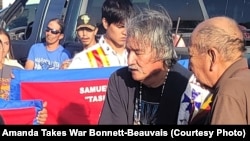
Bodies of Indian boarding school students make their journey home
More than 130 years ago, three Oglala Lakota youths from the Pine Ridge Indian Reservation in South Dakota traveled by train to the Carlisle Indian Industrial School in Pennsylvania.
But James Cornman, Samuel Flying Horse (also known as Tasunke Kinyela) and Fannie Charging Shield, like dozens of other Carlisle students, contracted tuberculosis, a disease that thrived in crowded school dormitories. They were buried in the school cemetery until this week, when a delegation from Pine Ridge arrived to take them home.
The car carrying their remains returned to South Dakota, making stops at the Yankton and Rosebud reservations before traveling in a procession through Pine Ridge.
Amanda Takes War Bonnett-Beauvais, whose ancestor Thomas Marshall was also buried at Carlisle, was among those who gathered in the town of Martin to pay their respects.
“It's an event that's really emotionally sad, but at the same time, it's a really educational event because it brings forth what happened in the boarding school era,” she told VOA. “Even though it's a historical thing that had happened 130 years ago, the effects of what those kids, their families, endured are still ringing into our family infrastructures today.”
The children’s remains were taken to a reservation funeral home; tribe members and descendants will meet Monday to discuss where they will be buried.
Did feds use, dispose of toxic chemicals on Nevada reservation?
The Associated Press this week revealed evidence that the federal government may have used component chemicals of the toxic herbicide Agent Orange (AO) as weed control on the Duck Valley Indian Reservation in Nevada.
The Shoshone-Paiute tribes who make their home at Duck Valley have long struggled with widespread illness and cancer, which they believe is linked to contamination of soil and water by pesticides and other chemical waste.
The Bureau of Indian Affairs (BIA) managed the reservation until 1993. During the 1950s, BIA operated a maintenance shop on the reservation and improperly disposed of diesel and other oils by pumping them into the earth through a shallow injection well.
Tests on samples from the sump, soil and floor drains around the building revealed that BIA had stored a dangerous assortment of chemicals, including waste oil, arsenic, copper, lead, cadmium and AO components.
Although new wells were installed in 1992, the community was exposed to contaminated water for years, leading to numerous cancer deaths, particularly among former school staff and students.
Read more:
Tribes lack resources to fight climate change along Pacific Northwest coastline
Over two dozen tribal nations along the Oregon and Washington coasts face climate challenges such as rising sea levels, ocean acidification, extreme heat, increased wildfire risk and declining mountain snowpack.
A recent report from the Tribal Coastal Resilience Portfolio of the Northwest Climate Resilience Collaborative shows that tribes have drawn up plans for combating extreme weather events, but they lack the funds, partnerships, technical assistance and personnel to put plans into action.
“Some of the challenges that we face on the coast are due to the magnitude of some of the projects that we need to undertake,” Quinault Indian Nation Natural Resources Technical Adviser Gary Morishima told the collaborative during one of a series of listening sessions conducted among more than a dozen Pacific Northwest tribes.
The Quinault tribe, for example, is working to relocate two villages vulnerable to climate change.
“That’s a multimillion-dollar, multiagency effort,” Morishima told the collaborative. “It’s very difficult to integrate our plans and priorities for village relocation with those of the agencies and constraints on available funding.”
Read more:
Crackdown on fake sober living homes push hundreds into Arizona streets
ProPublica and the Arizona Center for Investigative Journalism this week reported that a crackdown on fraudulent addiction facilities — so-called “sober living homes” — in the city of Phoenix has left hundreds of mostly Native American men and women homeless with no access to care.
As VOA reported in February 2023, fraudulent substance abuse providers targeted, lured and sometimes kidnapped Native Americans into sober homes across the city, billing Arizona Health Care Cost Containment System (AHCCCS) for services never rendered.
In October 2023, AHCCCS suspended the licenses of 12 sober living centers, adding to the list of more than 300 centers shut down by the state in 2023 because of allegations of Medicare fraud.
Thirty of the providers accused of fraud have been cleared to reopen and once again bill Medicaid for reimbursements.
“This is far from over, Navajo activist Reva Stewart told VOA Wednesday. “People are still getting recruited. People are still dying.
She shared video (above) that she said shows a group of recruiters coercing an intoxicated man into a transport van.
“Every morning, just on my way to work, I see like 20 to 25 Native people just hanging out by the Indian hospital,” she said.
Operators of fraudulent sober homes are known to frequent the Phoenix Indian Health Center and other locations, luring addicts and the homeless with promises of a warm bed and treatment.
Read more:
North Carolina Cherokees open state’s only marijuana dispensary
The Eastern Band of Cherokee Indians in North Carolina launched its first ever adult recreational marijuana sales on September 7, taking advantage of tribal sovereignty in a state where growing, possessing, using or selling cannabis products is illegal.
More than 4,000 customers showed up at the Great Smoky Cannabis Company in the Qualla Boundary; some waited in line for hours to purchase from a menu of 350 products.
Read more:
Native American news roundup, Sept. 1-7, 2024

Montana Senate candidate accused of making racially charged remarks about Indians
Tim Sheehy, the Republican candidate for U.S. Senate in Montana, is facing widespread criticism after the Flathead Reservation's Char-Koosta News this week published four audio clips in which the candidate appears to have made "racially tinged comments" about Native Americans on the Crow Reservation in Montana.
During a November 2023 fundraising event, Sheehy spoke about branding and roping cattle on the Crow Reservation alongside his Crow ranching partner, remarking that it was "a great way to bond with all the Indians being out there while they're drunk at 8 a.m."
During a separate event four days later, he described riding a horse in the Crow Reservation's annual parade, calling parade attendees a "tough crowd."
"They let you know if they like you or not. There's Coors Light [beer] cans flying by your head as you're riding by," the candidate said.
The Char-Koosta News reports it is working to verify the audio, and Sheehy's campaign has not issued any statement.
Levi Black Eagle, the Crow Nation's secretary for the executive branch, told Montana television station KTVQ that while Crows tolerate "good-natured ribbing," Sheehy's comments perpetuate old racist stereotypes.
"It's really disheartening, especially from an individual, a candidate running for such a high office, you would expect more from those individuals," Black Eagle said. "I think it's a majority of the community that fights hard to negate those stereotypes, and to have them perpetuate in such a way is just, it's really disgusting. And we don't stand for it."
The report has sparked outrage among other Native American communities in Montana, a state where Indigenous people make up about 6% of the population; they are calling for an apology.
Read more:
Arizona tribal enrollment numbers are valid proof of US citizenship
Voting advocacy groups in Arizona are working to clear up confusion over a recent U.S. Supreme Court ruling that may discourage Native Americans from voting in November's general election.
Through an unsigned order, the Supreme Court on August 22 sided with the Republican National Committee and Republican lawmakers in Arizona, reinstating a law that requires voter registrants to prove their U.S. citizenship when filling out state voter registration forms.
The decision suggests that anyone registering to vote using state-issued voter registration forms must provide documentation of U.S. citizenship such as a birth certificate or valid passport.
Patty Ferguson-Bohnee, a law professor at Arizona State University, called the ruling "discouraging" but pointed out that Native Americans were automatically made citizens a century ago.
That means that Native voters in Arizona need only to provide their tribal enrollment numbers as proof.
Read more:
Nevada tribes seek to protect 19th-century massacre site
Native American tribes in Nevada are concerned about a new federal solar development plan that could affect the proposed Bahsahwahbee National Monument.
The U.S. Bureau of Land Management's Western Solar Plan, released August 29, designates 4.8 million hectares in Nevada for solar projects, including areas near the site of the Bahsahwahbee monument. The site is historically significant, as it was the location of massacres of the Newe people in the 19th century and remains a sacred space for tribes that hold ceremonies there.
While the solar plan excludes certain Native American cultural sites, tribes worry that the lack of formal national monument status leaves Bahsahwahbee vulnerable to development.
"I am stunned and confused that while our tribes are in discussions with the Biden-Harris administration about establishing this monument, the BLM just issued a plan allowing the graves of our massacred ancestors to be bulldozed," said Amos Murphy, chair of the Confederated Tribes of the Goshute Reservation.
The Ely Shoshone, Duckwater Shoshone and Goshute tribes call the area Bahsahwahbee (Sacred Water Valley). Located near Nevada's Great Basin National Park, it is the site of three massacres in which the U.S. Army and armed vigilantes killed hundreds of their ancestors.
Efforts to secure national monument designation for the site are ongoing, with support from Nevada Senator Catherine Cortez Masto, a Democrat. Tribes are urging the Biden administration to take swift action to protect the area.
Read more:
Native Americans share stories about beings 'other than human'
South of the town of Toksook Bay on Nelson Island, Alaska, stands a hill known as Qasginguaq, which Yup'ik tradition says is the home of the Ircencerraat, beings described as "other than human."
"The young people that have seen them when they're playing state that they're about half their size," Toksook elder and cultural adviser Mark John told Native America Calling this week. "They have the ability to appear and disappear at will, and they live in a different dimension … if they appear to you in a human way out in the wilderness and they invite you to their home, spending a day at their home is like spending a year when you go back out."
John was among several guests and callers from across Indian Country this week who shared stories and traditions about "little people," beings that have parallels in cultures across the globe.
Listen here:
Tribes celebrate Klamath River dam removal
Construction crews on August 28 removed the fourth and final dam on the Klamath River in Oregon. As VOA’s Matt Dibble reports (below), Klamath, Yurok and Karuk Tribe were there to celebrate.
- By Matt Dibble
Tribes celebrate removal of dam, revival of community along Klamath River
For more than a century, dams have blocked fish migration on California’s second-largest river. VOA’s Matt Dibble takes us to the removal of the last of four dams, a victory for Native Americans who depend on the river.
Native American news roundup August 25-31, 2024
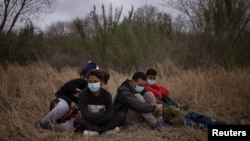
Cherokee Nation denies it helped enable trafficking of migrant children
Cherokee Nation Principal Chief Chuck Hoskin, Jr. has refuted allegations that Cherokee Federal, a division of the tribe’s business arm, Cherokee Nation Businesses, has played a role in the sex trafficking of migrant children at a California emergency intake facility.
"For over two years, Cherokee Nation and Cherokee Federal have been wrongly and unjustly smeared through unhinged conspiracy theories spread by a select few," Hoskin said.
In 2021, the U.S. Department of Health and Human Services awarded Cherokee Federal a $706 million contract to process unaccompanied children at a facility in Pomona, California, and reunite them with families and/or sponsors.
Senators Chuck Grassley (R-IA,) Bill Cassidy (R-LA,) and Ron Johnson (R-WI) hosted a roundtable discussion in Washington July 9 in which HHS whistleblowers Deborah White and Tara Rodas accused the HHS Office of Refugee Resettlement (ORR) and Cherokee Federal of prioritizing “speed over safety” in releasing unaccompanied minors.
They cited instances in which children were turned over to poorly or entirely unvetted “sponsors,” including criminals and, in one case, a member of the violent MS13 gang, despite an urgent “do not release advisory” which Rodas sent to HHS officials and Cherokee Federal staff.
Sen. James Lankford (R-OK), who serves on the Homeland Security and Governmental Affairs Committee and Senate Select Committee on Intelligence, participated in that roundtable. During a recent community meeting in Tahlequah, Oklahoma, he denied that Cherokee Federal engaged in placing children in unsafe situations.
"During that hearing, I was talking about HHS and their decision-making and some of my colleagues were talking about Cherokee Federal," Lankford said. "I think that was unfair of how that was pulled in, because that wasn't their job for the final selection."
Cherokee Federal's job was to take care of the children after they crossed the border, Lankford said.
The New York Times in 2023 reported that the Biden administration had lost track of 85,000 children.
The Center for Public Integrity says that figure is misleading and only represents the number of children who could not be reached during follow-up welfare checks.
Senators to Agriculture Department: Act swiftly to restore food deliveries to Indian reservations
A bipartisan group of senators is urging the U.S. Department of Agriculture, or USDA, to address severe delays and issues in a federal food distribution program that delivers food to eligible households on Indian reservations and other designated areas. The program is known as the Food Distribution Program on Indian Reservations, or FDPIR.
“Families that participate in this program do so at the expense of being eligible to participate in other federal food assistance, like the Supplemental Nutrition Assistance Program (SNAP),” reads an August 23 letter to Agriculture Secretary Thomas Vilsack and signed by Senator Jeffrey Merkley (D-OR) and six Senate colleagues.
“Further, many Tribal households choose to participate in FDPIR over SNAP because they do not have access to grocery stores so families have limited options for assistance, should they face delays in their FDPIR deliveries.”
In March, the USDA consolidated the food delivery contractors to a single contractor in Kansas City, Missouri, over the objection of tribal leaders. Since then, deliveries have been sporadic, at best.
A tribal program director on the Rosebud Reservation in South Dakota spoke to VOA on condition of anonymity.
“The program usually serves 1,100-plus people a month; about a hundred of them are elders,” she said. “We usually get four to five trucks of food a month. But our May trucks were delayed, and by June, we ran out of meat and frozen foods. In July, we didn’t get our trucks until the end of the month.”
The FDPIR is billed as a supplemental food program, but for many families on the reservations, these deliveries make up their entire monthly food supply.
“We normally receive ours the third Monday of every month,” she added. “But in July, we didn't get our trucks until the end of the month, and we’re still waiting on our August deliveries.”
Some tribe members have the option of shopping off-reservation, using monthly, electronically-delivered SNAP benefits – that is, if they have transportation and can afford high supermarket prices.
“We also have a mobile vendor,” she said. “They come around the day before SNAP benefits come out. They charge whatever they want.”
Senate lawmakers have given the USDA until September 9 to report and document reasons for the delays. The USDA says it is working with the Missouri contractor to fix the backlog but tribal leaders say they aren’t working fast enough.
Democrats make strong appeals to Native voters, but have they missed the mark?

The Native American Caucus, meeting at the Democratic National Convention in Chicago, opened its first meeting earlier this week with a prayer.
Amelia Flores, who chairs the Colorado River Indian Tribes in Arizona, introduced herself in the Mojave language and called on "Father, Creator" to bless Democrat leaders.
"We ask that you grant them wisdom and that our spirits will remain in a positive attitude throughout the next four days here. … We are gung-ho for our vice president and newly elect, with your favor, the first woman president of the United States," she said.
More than 150 Native American delegates representing tribes across the U.S. participated in the convention this week. They brought a unique set of concerns that include safeguarding tribal sovereignty, clarifying their relationship with the federal government and overcoming voting barriers.
Native vote power
Speaking with VOA in July, Association on American Indian Affairs Director Shannon O'Loughlin, a citizen of the Choctaw Nation in Oklahoma, emphasized that Native Americans have become an increasingly important voting bloc.
"If we do show up, and we do vote locally and nationally, we have the power to change the direction of the candidates and who's chosen," O'Loughlin said to VOA in July. "We saw that in the last election."
That said, she notes some states' efforts to discourage Native voters. In 2020, for example, the Native vote in Arizona helped swing the election in Biden's favor. Two years later, Republican lawmakers passed a law requiring Arizonans to prove U.S. citizenship, a hardship for many Native voters.
Lower courts rejected the law, and the Republican National Committee has called on the U.S. Supreme Court to decide in time for the state to begin printing ballots.
A look at the numbers
According to the Native American Rights Fund, out of nearly 6.8 million American Indians and Alaskan Natives, 4.7 million are older than 18 and registered to vote.
It is commonly assumed that Native American voters favor the Democratic Party. But some studies show otherwise:
Oklahoma State University researchers in 2016 conducted an internet poll in which 46% of Native American respondents identified as Democrats, 26% as Republicans and 25% as independents.
A 2022 Midterm Voter Election Poll by the African American Research Collaborative showed similar numbers but also revealed that Native American voters are less likely to believe either political party is truly committed to advancing their issues and priorities.
"We obviously want to look at the numbers, which are very interesting and important, but I think what's more telling at the end of the day is the fact that Native Americans are not really attached and don't have a solidified relationship with either party," said Gabriel Sanchez, a senior fellow in governance studies at the Brookings Institute.
"Native American voters overwhelmingly tell us they're not really partisan in how they approach voting decisions. It's more a campaign season to campaign season evaluation of which party they perceive to be better for their communities," he noted.
Sanchez told VOA that Native Americans are usually represented, at least symbolically, in political conventions. He observed, however, little Native presence at the Republican convention in mid-July.
In contrast, Native Americans showed up in force at the Democratic convention this week to support Kamala Harris' bid for the White House, and they heard from prominent Democrats, including Governor Tim Walz (D-MN), the vice presidential nominee.
"We have 11 sovereign nations, Anishinaabe and Dakota, and our history in Minnesota, just like the rest across this country, is dark," he said. "But in Minnesota, we've acknowledged it's not just enough to admire a problem.
"What are you going to do to make a difference? What are you going to do to partner? What are you going to do to acknowledge the first Americans? And what are you going to do to understand that our state of Minnesota is stronger because of our 11 sovereign nations?"
Senator Corey Booker (D-NJ) expressed solidarity with Native voters, noting that Black and Native Americans face similar challenges "with a justice system that treats you better if you're rich and guilty than if you're poor and innocent, with a health care system where literally the lowest life expectancy in the nation is Native American and African American men."
But will these messages resonate with Native voters, particularly those registered as Independents?
"An issue that's nowhere near on the radar of either party's platform is missing and murdered Indigenous women," Sanchez told VOA, citing a First Nations Development Institute survey of Native Americans showing this to be a top concern.
"And I think if either the Democrat or Republican Party can embrace that particular issue, it will go a long way."
Native American news roundup August 11-17, 2024
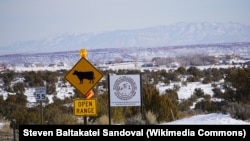
Researchers debunk myths about ballot collection on Indian reservations
A study by the University of Utah’s College of Social & Behavioral Science reveals that ballot collection on Native American reservations effectively lowers voting barriers without evidence of vote fraud.
Ballot collection is a system by which voters rely on third parties to collect and submit their absentee or mail-in ballots. Distances, poor mail service, bad roads and lack of transportation mean that Native Americans on rural reservations rely more on ballot harvesting than other voter blocs.
Despite its benefits, ballot collection faces opposition and restrictions in several states, including Utah, where it has been banned. Critics argue it is vulnerable to fraud, though the study finds no documented cases of such issues.
A father-son pair of researchers analyzed data from the conservative Heritage Foundation. They found that voter fraud related to ballot collection is extremely rare, occurring only in 0.00006% of votes cast – that is, six cases of proven fraud for every 10 million votes cast in the U.S.
Read more:
Child rights advocate: boarding school abuses continue globally
The U.S. Department of the Interior recently released the second volume of its investigation into the federal Indian boarding school system, revealing that at least 900 Native American children died in these schools after having been forcibly separated from their families, communities and cultural heritage.
An editorial in The Hill this week argues that residential schools, including modern orphanages and children’s homes, still cause harm across the world today.
“Residential education in many cases fulfills the definition of an institution and causes similar harm to children,” writes contributing author and British child rights advocate Enrique Restoy. “Children in residential facilities face an increased risk of abuse and often have a damaged sense of belonging and emotional health.”
Adding to the problem, Restoy says boarding schools are typically regulated by government ministries of education and often located in remote locations without proper oversight, which “intrinsically lends itself to students enduring abusive practices of various kinds from staff, including emotional, physical and sexual abuse.”
The writer calls for a shift in support towards keeping children within their families while providing education, rather than separating them for care and schooling.
Read more:
Clergy want role in boarding school truth and reconciliation process
In a related story, as Congress considers legislation that would create a federal commission to address the trauma from Native American boarding schools, U.S. Catholic bishops are calling for an amendment that would allow religious communities a role in the process.
The proposed Truth and Healing Commission on Indian Boarding School Policies Act would set up a commission and various advisory committees to investigate and acknowledge past injustices at these schools. The bishops argue that since many of these schools were run by Catholic and Protestant groups representatives from these religious communities should also be included.
The bishops' letter, sent on July 25 to key congressional sponsors and signed by several high-ranking church officials, stresses that including religious communities is crucial for comprehensive healing and reconciliation. They also advocate for voluntary cooperation rather than broad subpoena powers, as they claim to have already been transparent and cooperative.
Read more:
Cheyenne Arapaho writer honored as part of unique literary project
Native American author Tommy Orange has already begun thinking about a new novel that none of us will live to read.
Orange, a citizen of the Cheyenne and Arapaho Tribes in Oklahoma born and raised in California, has been selected as the next writer for the Future Library Project (FLP).
An initiative launched by Scottish artist Katie Paterson in 2014, FLP aims to collect an original work by a popular writer every year for a century. The works will remain unread and unpublished until 2114, when they will be printed on paper made from trees the artist planted in Norway a decade ago.
Orange is the author of two novels exploring urban Native American identity. His 2019 debut novel “There There,” an examination of urban Native identity, earned him a Pulitzer nomination; his follow-up novel “Wandering Stars,” is on this year’s Booker Prize longlist.
He tells the Guardian newspaper that being involved in the Future Library means he still has hopes “that we will have a world to live in with books in it in a hundred years, or 90 I guess, and I think I need to keep that hope alive, need to actively cultivate that kind of hope in the longevity of the human project.”
Orange isn’t sure what kind of book he will write for the FLP and wonders what kind of reception it will get from critics in the 22nd Century.
“I think it’s a little scary writing for people who will most definitely deem us stupid and inferior in many ways just as when we look back a hundred years, we can see clearly all the problems we had just being decent human beings,” he said.
Read more:





